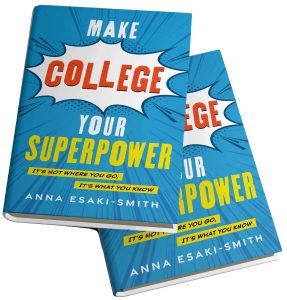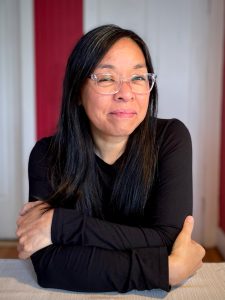Author Anna Esaki-Smith provides another meaning to ‘the old college try’ trope.
By Alan Oda, P.C. Contributor
 Trying to find the right college is one of the more difficult questions encountered by a student preparing for their future education. To help navigate this seemingly treacherous journey, Anna Esaki-Smith has written “Make College Your Superpower: It’s Not Where You Go, It’s What You Know,” released in April by Rowman & Littlefield (208 pages; SRP $30, ISBN-13: 978-1538184103).
Trying to find the right college is one of the more difficult questions encountered by a student preparing for their future education. To help navigate this seemingly treacherous journey, Anna Esaki-Smith has written “Make College Your Superpower: It’s Not Where You Go, It’s What You Know,” released in April by Rowman & Littlefield (208 pages; SRP $30, ISBN-13: 978-1538184103).
The daughter of Japanese immigrant parents who valued a college education, Esaki-Smith — a journalist, international education consultant and former JACL scholarship awardee — majored in Asian Studies at Cornell University. In her book, she said she was admitted with a 3.28 grade point average, while “some estimate that Cornell’s average admitted student has a 4.07 GPA.”
Esaki-Smith says her annual tuition was about $13,000, a sharp contrast to the current $90,000 for tuition, room and board. Eventually, she enrolled at the Columbia University School of Journalism. She says she could have learned the skills at a local newspaper, “but Columbia had arguably the most competitive journalism program in the country. And this was when brand meant something.”
She realizes not everyone should go to college, noting there are in-demand occupations including plumbers, electricians and other vocations. Still, Esaki-Smith cites the statistic that the annual salary of a college graduate averages $78,000 vs. the average high school-only graduate salary of $45,000. A major point of the book: A college degree is still valuable — but how to obtain the diploma necessitates re-evaluation. Additionally, someone with a Google Career Certificate, in lieu of a college degree, can earn a median salary of $76,000.

“Make College Your Superpower” author Anna Esaki-Smith
“Students should be taking a personal inventory of their strengths and desires that will ultimately determine their success,” Esaki-Smith writes. “Students who pick schools that match the potential contributions they can make are more satisfied with their experiences and, ultimately, their professional outcomes.”
Her book examines and re-evaluates the consternation of the application process to hypercompetitive schools over less-prestigious-yet-still worthwhile alternatives.
While Ivy League schools always have a significant number of applicants, Esaki-Smith describes the success of New York University. The state school had an acceptance rate of just over 36 percent for its Class of 2018; nine years later, the acceptance rate is just over 8 percent. She lauds the quality of the school’s faculty, programs and facilities, yet there were no significant changes at NYU over the past decade.
Esaki-Smith writes, “People battle to get into exclusive universities just because so many others also want to get in. It’s the herd mentality at work.”
Esaki-Smith details the complexity of the admissions process, stating beyond GPAs, extracurriculars and letters of recommendation are a school’s in-state vs. out-of-state high school students, international vs. domestic students and considering first-generation collegegoers vs. students whose parents possess a college degree.
Nonetheless, Esaki-Smith learned that one’s overall GPA, particularly in college prep classes, was most important, while SAT and ACT scores were “significantly below,” and AP and SAT II test scores were often viewed as insignificant.
The author also writes that students should not be afraid to fail, as it may actually help refine both the student’s search for a school as well as their path of study. She titled the chapter “When Deciding What to Study, the Key Thing Is Just to Decide,” later adding, “If you can’t make a decision, the world will make one for you.” Students who learn to acknowledge their limitations, she argues, can better focus on their strengths and create solutions better tailored and, ultimately, more satisfactory to them.
Esaki-Smith acknowledges that choosing a STEM (science, technology, engineering, mathematics) major is considered more prestigious and lucrative compared to education and the social sciences. Teachers make far less than engineers, yet a number of well-known individuals credited their teachers as significant to their success.
She quotes actor Jon Hamm (“Mad Men”), who said, “I’ve had some of the greatest teachers in the world, and I owe a huge portion of my existence to them.” His teachers, who encouraged and mentored him after the early loss of his parents, “can be the difference between, literally, life and death.” Esaki-Smith acknowledges that assigning a financial value to a profession offering that kind of experience is impossible. “And the world would be a poorer place if everyone pursued financial gain above all else,” she said.
“Technology has changed everything,” writes Esaki-Smith, who argues skills, abilities and competencies are now priorities. But this does not mean humanities majors are useless. She writes, “You have even more reason to celebrate, as the ability to think, process information and communicate has never been held at such a premium.” She believes “as interest in STEM subjects rises, demand for university graduates with soft skills ideally will increase in tandem.” She describes that the growth of AI (artificial intelligence) will need more than engineers and computer scientists to tackle the ethical issues around AI and its impact on communication and relationships, the human side of technology. Quoting a recent survey of 650 employers, “64 percent of companies have difficulty finding qualified candidates with critical thinking skills.”
Esaki-Smith also describes nontraditional majors, often a combination of different academic disciplines. A traditional marketing degree at the Wharton School (University of Pennsylvania) includes courses in accounting, finance, management and economics, while Southern New Hampshire University offers online programs in digital and social media marketing.
One of the more intriguing chapters in the book is titled “Follow Your Competencies, Not Your Passion.” Esaki-Smith quotes several well-known celebrities who address the importance of passion, including Oprah Winfrey (“Passion is energy”) to Steve Jobs (“The only way to do great work is to love what you do”). Yet, the author writes many find success when they pursue something outside of one’s passions. She tells the story of Sara Blakely, the inventor of Spanx, someone who was unable to pass the LSAT. After a variety of odd jobs, she realized she wanted to be self-employed. When getting ready for a party, Blakely cut the feet off a pair of pantyhose to provide proper support for her outfit while allowing her to wear sandals. She then created Spanx body shapewear, inspired by her modified panty hose. Her company was recently valued at $1 billion.
Regarding tuition, Esaki-Smith describes the “Chivas Regal effect,” the misperception that something is better than its competitors because of its higher price. Some colleges, meantime, raise their tuition to appear more prestigious, but offer discounts, financial hardship or merit to students to encourage enrollment. She documents Colby-Sawyer College, a small liberal arts college where every student receives a discount. The posted tuition is about $46,000, yet the average tuition is $17,500, a 62 percent discount.
Esaki-Smith uses the analogy of purchasing a cellphone to assist students in choosing a college. An Android device is generally less expensive, yet the iPhone smoothly integrates with other Apple products. Depending on one’s priorities, the pricier iPhone may be the better choice. For others, the affordable Android phone quite suffices.
With college, the student needs to consider programs, facilities, reputation, location and cost. Similar to evaluating a phone purchase, “Since you can’t have everything that you want, you need to prioritize needs and preferences to find the product that best suits your requirements.” Like the more well-known iPhone, prestigious schools have a well-known brand name with a higher cost. Brand is less important but still valued, argues Esaki-Smith. There is more of a reaction to an Apple product than many Android devices; similarly, some schools open doors more than others due to perceived branding.
Nonetheless, lesser-known schools might offer very adequate alternatives. Both the University of Oregon and Portland State University, the former having greater brand recognition, have partnerships with Nike. “So, if your dream is to work at an athletic apparel company, you may not need to go to a particularly fancy university,” Esaki-Smith wrote, adding, “Being a stellar student at a lower-ranked school rather than in the middle of the pack or lower on the totem pole of a more selective university might mean more opportunities.”
If brand is still important, Esaki-Smith notes the number of students who transfer from community colleges to the University of California, Los Angeles, and other schools, which have low freshman admission rates. Still, for those determined to attend an Ivy League school, another more affordable strategy is to apply to the Harvard “equivalent” overseas.
For example, University of Tokyo, aka Tokyo Daigaku, has a “yearly tuition just below $4,000, based on current exchange rates.” Another option: Engage in an online course offered by an Ivy League school, including a number of free options. Toward the end of her book, Esaki-Smith offers the reader a “decision navigator” to help students (and their parents) evaluate their best options for post-secondary education.
Esaki-Smith also emphasizes the importance of networking. She cites networking expert Ivan Misner, who says, “Networking is not about hunting, it’s about farming,” thus emphasizing building long-term genuine relationships.
And she encourages students to get to know their faculty and counselors, who can continue to provide support even after the student leaves the university. Eventually, building relationships allow for goodwill and reciprocity, with technology making networking more accessible and inclusive beyond the school attended by the student, writing, “Giving can lead to receiving.” By comparison, alumni networks are not sufficient, as Esaki-Smith says the student needs to be more intentional and strategic in their networking efforts.
In an interview, Esaki-Smith said, “I felt compelled to write a book about college admissions because it’s never been a better time to be a student.” She admits “that may seem counterintuitive, considering all the frenzy surrounding college acceptances.”
However, Esaki-Smith recognizes the changes in both the economy and the workplace, which are both “becoming increasingly skills-oriented, and there’s so much data available for students to tap when making decisions, applying to college should be wholeheartedly embraced as an opportunity to reach one’s goals.” She states in her book “more than ever, your future will be determined more by what you learn in college than where you went.”
“My book, too, dispels some old beliefs that brand is best when applying to universities,” said Esaki-Smith. “Students were preoccupied with the Ivy League and other elite schools 40 years ago, back when the economy was dominated by big industrial and financial companies.”
She says a number of traditional industries have been disrupted by technology, while big tech now increasingly dominates the economy.
“Why hasn’t our thinking about where to go to university changed as well?”
This article was made possible by the Harry K. Honda Memorial Journalism Fund, which was established by JACL Redress Strategist Grant Ujifusa.



